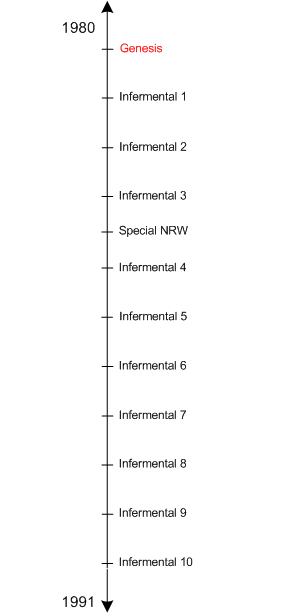|
Lecture held by Vera Body on
June 3rd 1986 at ‘Städtisches Museum Abteiberg’,
Mönchengladbach (Germany)
[...] Since the beginning of the 60s Name June Paik’s
and Wolf Vostell’s electronic images have caused the birth
of a new genre: VIDEO. Its decisive charcteristics in contrast to
other art forms - such as painting, photography, film and theatre
– were clarified into the following three functions not long
after by Wulf Herzogenrath:
1. the immedeate control of the image
2. the manifold electronical possibilities
3. the reproduction of the image on the monitor.
As a vital element I would add the perception of Jean-François
Lyotard. He states that with video we have images ‘which,
contrary to the tradition of photography and cinema, and also contrary
to a large part of painting, are only produced and not reproduced.
To find something equivalent in painting, one would have to look
in the direction of abstract painting which is not – simply
said – a reproduced image. In this way what is known, seen
and heard is nowadays being less known, seen and heard. Machines
bring forth facts which by far surpass our sensous adaptability.’
In the 60s and 70s video was increasingly employed as an artist
means by musicians, performance artists and other artists. The discovery
of video as a mirror, as a possibility of self-portrayal, of the
audience’s potential participation in the events (as in works
by Joan Jonas, Peter Campus, Frank Gillette, Dan Graham and others)
created the effortless realization of synchonization between reality
and its presentation. Live enviroments made possible through ‘closed
circuits’ (Nam June Paik: Video-Buddha, Bruce Nauman: Video-corridor, or
Peter Campus: Interface and others) and the electronic
experiments of Fluxus which hoped to break the pseudo-transperancy
of the medium television (René Berger) shaped the early stage
of video art. Douglas Davis described the artistic video of the
70s as anti-television. Media ideologies from Walter Benjamin (photography),
Bert Brecht (radio), and Marshall McLuhan (TV-electronic age) provided
the intellectual background of the new electronic art. The esoteric
atmosphere of the galleries representing the minimal-concept art
and video art in the 70s cultivated the individual mythology of
their artists, but could not become a CULT programme for a broad
public even after initial effort. The early medium-exploring age
of video art (David Antin), which a short time later was to be quoted
as a boring epoch, met with a crisis at the end of the 70s. Only
a few collectors and some institutes were interested in the new
art form. Outstanding characteristics, such as personal participation
in events (mirror effect), the semiotic use of objects (Minimal
ART) and the intimate approach to the medium survived the descent.
Facing the fact that installatios in every documenta, Biennale in
Venice or the Stedelijk Museum in Amsterdam continued in the 80s,
the individual product of a video cassette is becoming more and
more significant. Considering the worldwide epidemic of video festivals
(Tokio, Locarno, Montbéliard, Toronto, Kijkhuis-Den Haag,
San Francisco, Montreal, Rio de Janeiro, Marl, Salsomaggiore etc.)
which have not only increasingly been connected with awards, but
also with the presence of representatives of public and private
television, there is no doubt that broad change in form and content
of video in the 80s can be concluded. Moreover, Video/Book projects
(Infermental/LichtBlick) are aiming at breaking the traditionally
limited circle of the video marktet.
As a circulating record of information (Oliver Hirschbiegel), the
video cassette became a quickly available carrier for interdisciplinary
works and the first international magazine on video cassettes INFERMENTAL
originated in 1980 with the ambition to collect and reorganise all
new directions of the electronic art. New genres and trends became
perceptible in this info – magnetic ‘lebensraum’
(Gábor Bódy).
On the occasion of his exhibition ‘The Immaterials’
at the Centre Pompidou in Paris in the spring of 1985 Jean-François
Lyotard requested that the encyclopedia of ours be electronic. I
am not claiming that INFERMENTAL is already as far as this, but
the objectives and methods we have been working with since 1980
are going in this direction. According to the concept of INFERMENTAL
the annually changing panels of editors endeavour – from the
presented material – to crystallize categories corresponding
to the context through which the various genres like New Narrativity
or Electronic Painting develop. [...]
|

